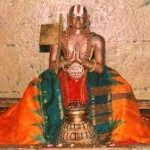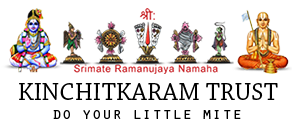What is the difference between Karma yogam and karma-anushtanam ?
Similarly, Aagnya kainkaryam & anugyna kainkaryam defined in shastras is a part of bhakti yogam practise or is it part of karma yogam ?
- Liked by
Hamsa-amma, namaskaram.
The dictionary meaning of the word ‘yogam’ is ‘to join’ or ‘to merge’ ‘to bring together’ different things. (for example, we often hear this word in the astrological context, where it refers to the amplified beneficial effects due to combination of two or more beneficial factors/ planetary alignments).
In the Vaishnava context, the word yogam refers to our ‘joining back in the pure kainkaryam of Perumal’. To always render kainkaryam to Perumal is our natural state; but in this lila vibhuti we are covered by ahankaram and mamakaram and all allied bad qualities; so we try to please ourselves in all our endeavors. When we give up this tendency and become pure again (totally free from ahamkaram and mamakaram) and engage in kainkaryam that is our Yogam with Perumal.
To enable our gradual progress towards this ultimate pure state, Perumal has arranged a gradual systematic system.
To begin with, He has given through sastras certain prescriptions and proscriptions. If we follow this nicely our life here will be smooth and nice, free from difficulties. Such following is called anushtanam. In our practise of anushtanam, the purpose of us following sastram is because it will bring good to us; we are not explicitly doing anushtanam for the purpose of pleasing Perumal.
When we gradually progress to the stage of doing all our activities for the purpose of pleasing Perumal, that will be karma yogam.
Similarly, the process of jnanam when progresses to the stage where we are eager to know about Perumal, our relationship with Him, His glories etc, that is Jnana yogam.
Similarly when we apply ourselves to the prescribed Bhakthi practises and progress to the stage of rendering all devotional service for the exclusive and explicit purpose of pleasing Perumal that is Bhakthi yogam.
Even a bhakthi yogi can do the anushtanam activities, but now he is doing them for the purpose of pleasing Perumal; not simply because it brings him good. He is depended only on Perumal for his own maintenance.
People like us, we are so steeped in self absorption that any of the above mentioned ‘yogam’ processes are very difficult for us. For us, the easiest way for ‘yogam’ with Perumal is the saranagathi process. Udaiyavar has assured this yogam for all of us; simply by his thiruvadi sambandam we are assured of this yogam.
Having received thiruvadi sambandam, now we can do the anushtanam activities, jnana process and bhathi activities; the difference now is we are doing all this simply for pleasing our acharyan and Perumal. We know very well that our half baked application to these activities is not what is going to get us back to Vaikuntam. It is acharya sambandam that is taking us back. In gratitude to that acharya sambandam, we apply ourselves to the prescribed processes.
I do not know about ‘ Aagnya kainkaryam & anugyna kainkaryam’. I hope some other member may be able to help us understand.
adiyen dasan.
Amma, I searched the internet for Aagnya – and anugnya kainkaryam. The below link explains these two terms in the first half of the essay.
https://ramanuja.org/sri/BhaktiListArchives/Article?p=dec2001%2F0203.html
I feel the writing is authentic to sampradaya philosophy. Kindly check for yourself.
I have only one reservation about this article. The author mentions: :
This is illustrated by the following verse from the Bhagavat Gita- "Shrui:smriti: mamaiva AgyA-yastAm ullanghya vartatE AgyAcchEdI mama drOhI mama bhaktOpi na Vaishnava:"
However, this sloka is not from Bhagavad Gita; it must be from some other source; it is likely some oversight or error occured in the citing the reference..
adiyen dasan.
adiyen dasan.
Swamin, Anega kodi namaskaram for a very nice explanation and the references. Definitely was very useful, this doubt arouse when adiyen happened to read the stt “Oru prapannan sharanagati pannina aprom, he/she shldnt take karma yogam or bhakti yogam as his means to reach God”, what does this actually mean? this is where adiyen got confused, lets say a jeevatma gets bhagyam to get prapatti from an acharyan at an early age, post which he will still have to do his anushtanams and kainkaryams isnt it ? Are these Aagyna kainkaryams part of bhakti yogam ? And since it is very difficult to follow in todays kaliyugam, prapatti maargam is the soln? Somwhere “margam” (prapatti margam) “yogam” words seem to have deeper inner meaning which adiyen is having confusions. This is my doubt swami. Sorry for a long post.
Dasan Adiyen
🙇♀️🙏
Amma, thank you for your reply.
You said “Oru prapannan sharanagati pannina aprom, he/she shldnt take karma yogam or bhakti yogam as his means to reach God”
Let me make a small change to this statement, please. “Oru prapannan sharanagati pannina aprom, he/she shldnt depend on karma yogam or bhakti yogam as his means to reach God”
Udaiyavar who ensured that we all will go back to Vaikuntam simply by associating with him, even in his ripe old 120 years age he was doing his sandhyavandanam regularly, which is one of the prescribed nithya anushtanam! But he did not depend on these anushtanam to go back to vaikuntam. He simply executed the prescirbed activities simply for the pleasure of Perumal and to set us the right example for us.
In our case, even after receiving prapatti, we should do the prescribed activities simply because that is what our Udaiyavar wants us to do and that is the example he has set for us, and doing so will please him. This is our reason, and nothing else. We are not dependent on these activities to burn our accumulated sins and get rid of material desires and eventually go back to Vaikuntam. The saranagathi process takes care burning sins etc. Yet, we do the prescribed activities for the pleasure of our acharyan / Udaiyavar / Perumal.
I do not now the contextual significance of the suffixes ‘yogam’ and ‘margam’.
adiyen dasan.
correction: last sentence should be “I do not know the contextual significance…..” adiyen.
Dhanyosmi swami, now after reading both these replies together and after analysing, adiyen is quite satisfied for now by God’s grace. Prapatti is the only maargam in kaliyugam which we shld depend on.
Thanks for the time and patience. 🙏🙏🙇♀️🙇♀️🙇♀️
Where can we find the glossary of terms (sanskrit) used in our sampradayam. Any ref in single source. adiyen feel difficult to remember several things because of lack of sanskrit knowledge.

I have asked for glossary of terms (sanskrit) and not various texts of the samprahayam. I have downloaded my requirement from the internet.
Jayaram swamy, namaskaram.
I have been using sanskrit dictionary links like the two pasted below. Previously there used to be another site based from Germany; it was very good; but of late I am unable to find that source through google search.
https://sanskritdictionary.com/
For each word the dictionary will list a range of meanings. Only if we have heard the sloka’s explanation from an acharya before then it is easy to identify the correct contextual meaning of the word from the dictionary and make sense of it.
If we have not heard the explanation from the acharya and try to use the dictionary list of meanings to make our own interpretation of the text, we will be totally confused and may even end up with wrong understanding.
adiyen dasan.

Kambandasan swamy,
Thank you for the links.
I do not know sanskrit to check the meaning of slokas. I do not know whether I will attempt al all. I am coming across many words during reading / listening. My idea is to have a ready reckoner of sanskrit words and it’s meaning for the regularly used words.
adiyen
- Liked by
